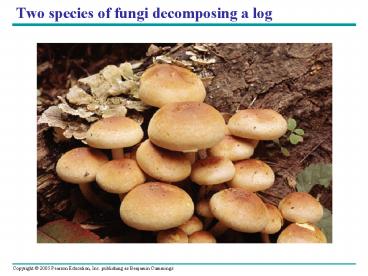Two species of fungi decomposing a log - PowerPoint PPT Presentation
1 / 18
Title:
Two species of fungi decomposing a log
Description:
Fungi secrete hydrolytic enzymes, digest the food outside their bodies and ... (a) A fruticose (shrub-like) lichen (b) A foliose (leaf-like) lichen ... – PowerPoint PPT presentation
Number of Views:124
Avg rating:3.0/5.0
Title: Two species of fungi decomposing a log
1
Two species of fungi decomposing a log
2
Fungi Characteristics
- All are eukaryotes and most are multicellular
- Fungi are heterotrophs that feed by absorption
- Fungi secrete hydrolytic enzymes, digest the food
outside their bodies and absorb the small
molecules - The bodies of fungi are composed of filaments
called hyphae that are entwined to form a
mycelium (the body) - Most fungi have hyphae divided into cells by
cross walls called septa - Septa have pores large enough to allow organelles
to pass through - Coenocytic fungi lack septa and consist of a
continuous cytoplasmic mass containing hundreds
of nuclei - The cell walls of fungi are made of chitin
- Fungi produce spores to reproduce, most of which
are haploid
3
Structure of a multicellular fungus
Reproductive structure.The mushroom produces
tiny cells called spores.
Hyphae. The mushroom and its subterranean
mycelium are a continuous network of hyphae.
Spore-producing structures
20 ?m
Mycelium
4
Structure of hyphae
Cell wall
Cell wall
Nuclei
Pore
Septum
Nuclei
(a) Septate hypha
(b) Coenocytic hypha
5
Types of Fungi
- Chytridiomycota are aquatic and primitive
- Zygomycota are terrestrial (bread mold)
- Glomeromycota are terrestrial, obligate symbionts
and form mycorrhizae - Ascomycota account for 75 of fungi, some famous
members (e.g., a. yeast that bakers and brewers
use, b. penicillin source, c. source of
aflatoxin, the most potent known natural
carcinogen, d. the source of many plant pathogens
(Dutch Elm Disease) and animal infections
(ringworm, athletes foot) and e. the fungi
component of lichen) - Basidiomycota include mushrooms and shelf fungi
and are important decomposers
6
Phylogeny of fungi
7
Zygomycota bread mold (Rhizopus)
8
Zygomycota parasitic fungus on mushroom
9
Glomeromycota mycorrhizae around roots
10
Ascomycota sac fungi
11
Penicillium (ascomycota), a mold commonly
encountered as a saprobe on food
12
The yeast Saccharomyces cerevisiae (ascomycota)
in various stages of budding (SEM)
Parent cell
Bud
13
Variation in lichen (ascomycota) growth forms
14
Anatomy of an ascomycete lichen (colorized SEM)
Ascocarp of fungus
Soredia
Fungal hyphae
Algal layer
Algal cell
Fungal hyphae
10 ?m
15
Examples of fungal diseases of plants (ascomycota)
16
Fungal production of an antibiotic
17
Basidiomycota (club fungi)
18
Review of Fungal Phyla































